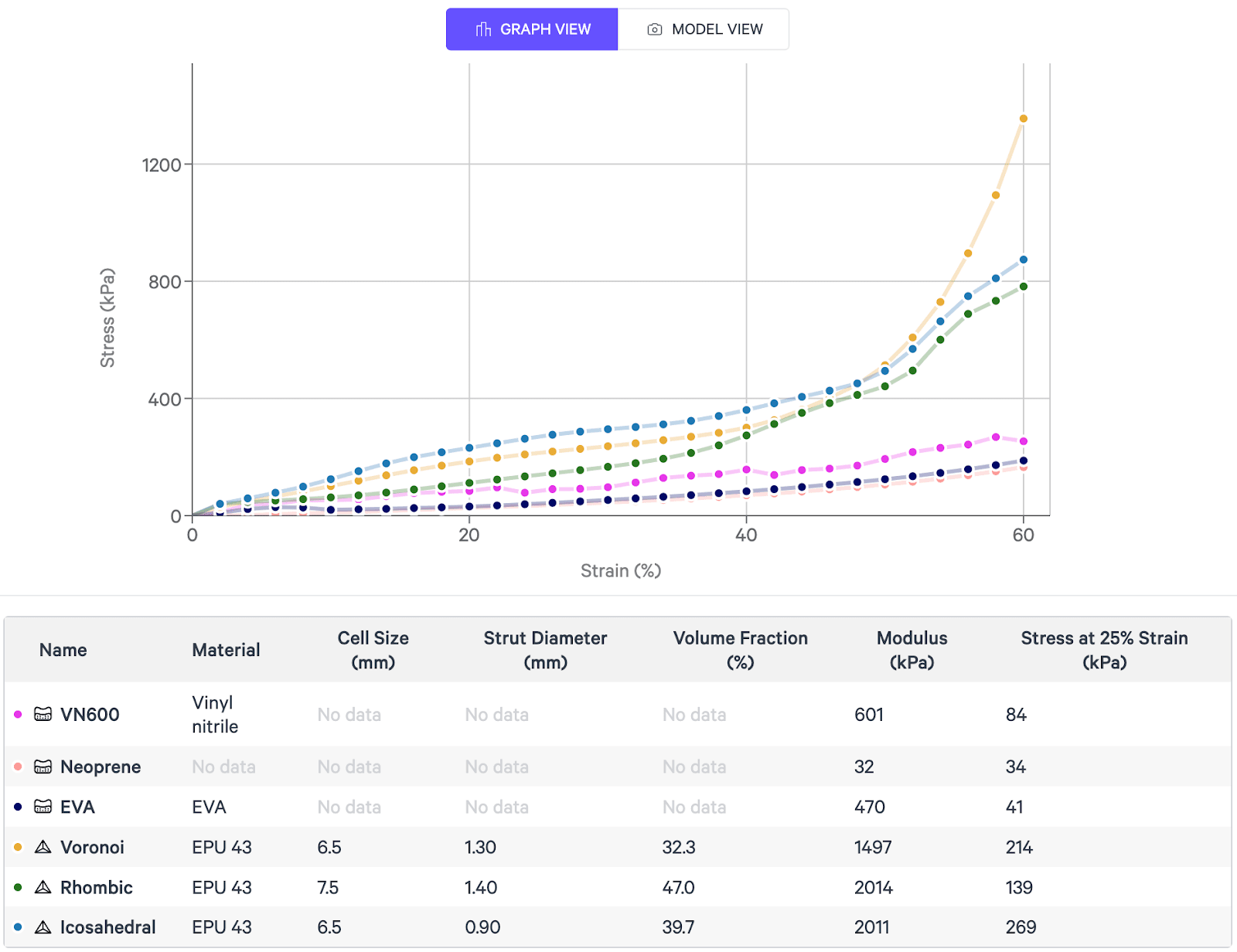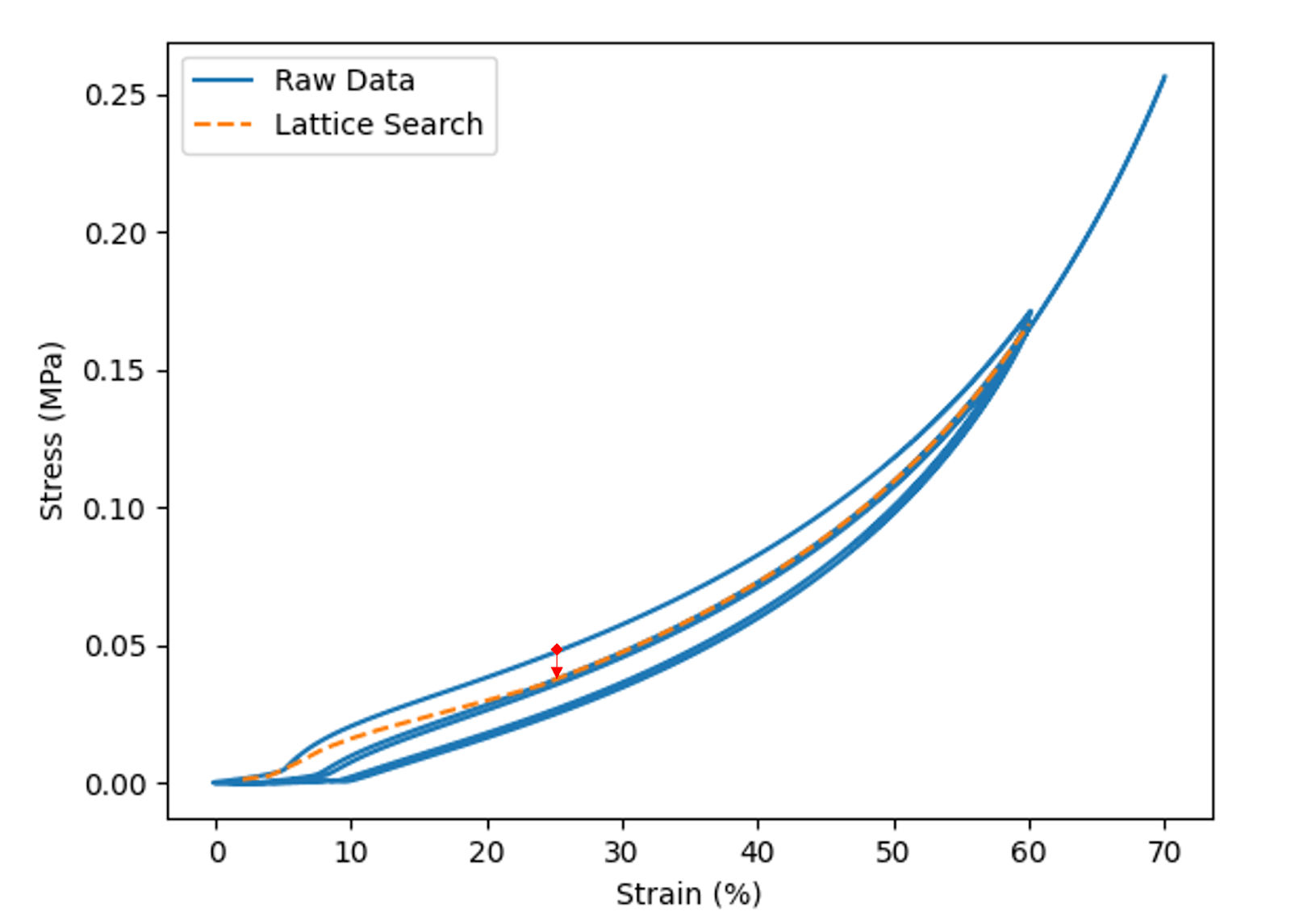Carbon Design Engine Helps Designers Improve on their Favorite Foams
By Ehsan Haghighat, Wilson Wong, Beth Bernhardt, Connor Tevault, Kelsey Reed, Clarissa Gutierrez, Kyle Kloster
Popular foams searchable in Carbon’s metamaterials library
Carbon Design Engine software helps users zero in on customized performance by providing both a lattice engine and a library of thousands of metamaterials with varying mechanical properties to select from. (You can read more about the metamaterials library here.) Carbon’s materials and simulation experts continue to expand those capabilities to make it as easy as possible for designers to tailor their parts to match targeted mechanical responses.
Toward that goal, the metamaterials library now includes compression data for several popular foam materials, such as neoprene and EVA. With this addition, the Design Engine Lattice Search interface offers side-by-side comparisons of foams and Carbon metamaterials.
Figure 1. Lattice search results including popular foams and Carbon materials
Users can now quickly identify lattice parameters with specific bulk properties, significantly reducing the design-test-and-iterate loop spent tuning parts to match desired performance.

Figure 2. Graph and table views of material comparisons
In the following section, we give technical details of the physical testing setup used to generate the foam behavior data available in the metamaterials library.
Technical details of foam characterizations
Physical testing setup
To produce the static compression data for the foam specimens displayed in the metamaterials library in this report, we used the following testing setup.
For each material, we used a foam puck with dimensions 75 mm x 75 mm x 25 mm. Before we conducted compression, the pucks were conditioned in a controlled environment, at 23°C and 50% relative humidity, for at least 12 hours before testing.
In our static compression setup, we used a circular indenter with a 50-mm diameter at a rate of 50 mm/min. For each specimen, two cycles of compression were applied: one cycle to 60% deformation (or when the load capacity of the cell was reached, whichever occurred first), then after the first cycle unloaded, a second cycle to max out the load cell (a 4,500-N limit). The results reported in the metamaterials library incorporate data from cycles, as described in the following section.
Modeling the data
Foams exhibit hysteresis when subjected to cyclic loading, owing to their visco-elastic nature.1 Consequently, the first loading cycle applied to a specimen can be stiffer than subsequent ones due to delayed deformation rebound. Figure 3 shows an example of this phenomenon. Note that, depending on the loading rate and rebound delay, the third and subsequent loading cycles can be very similar to the second. In many applications (insoles, for example), the second cycle is used to represent the mechanical characteristics of foams, because there is typically a repeated loading pattern. This makes the second cycle more representative of the material’s response.
In Lattice Search, we base the foam responses reported on a single curve primarily derived from the second loading cycle of each test. However, as Figure 3 depicts, the initial stress of the second cycle is zero due to the delayed deformation rebound. To address this, for strains below 25%, we scale the first cycle data down to match the second cycle at 25%, as shown in the following figure.

Figure 3. Stress vs Strain graph of multiple cycles compared to the curve used for lattice search
How to use foam testing data
We aim to facilitate the design process, to reduce iteration time by identifying parameters that achieve users’ desired part properties. The physical testing data now displayed in the metamaterials library offers an accelerated starting point for designers looking to match or improve the performance of foams in their models. However, as with any simulation or test, the data presented comes from simplified design spaces characterized in ideal, controlled environments. Therefore, the data provided is best used as a directional signal to aid in converging on final design choices rather than precise, complete descriptions of final part behavior. Actual part behavior depends on the specific use and is subject to variation inherent in manufacturing processes and different environments in which products are used. Users should validate model behavior in settings specific to their needs.
1Stone H. Fatigue Testing of Flexible Foams. Journal of Cellular Plastics. 1983;19(1):47-60. doi:10.1177/0021955X8301900106
3D as It’s Meant to Be
Interested in utilizing Carbon to accelerate product development? Reach out to us at sales@carbon3d.com to learn more!
